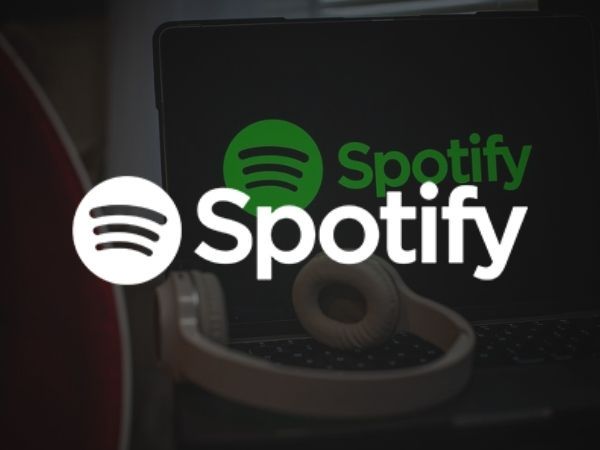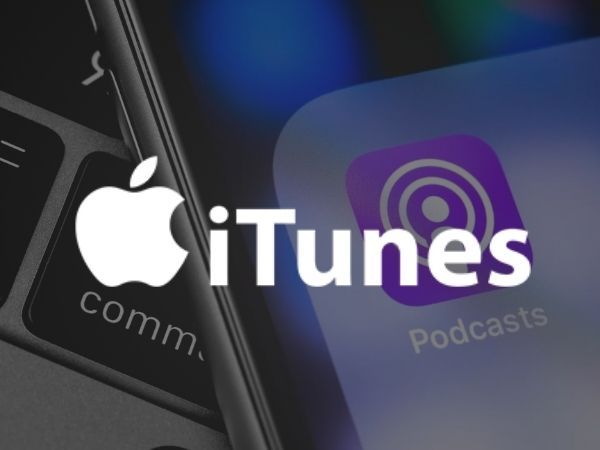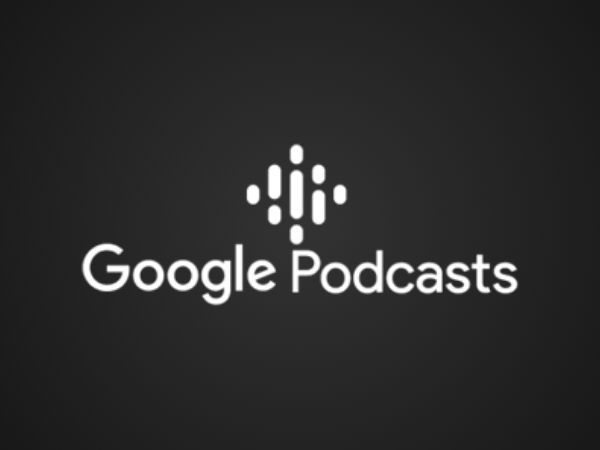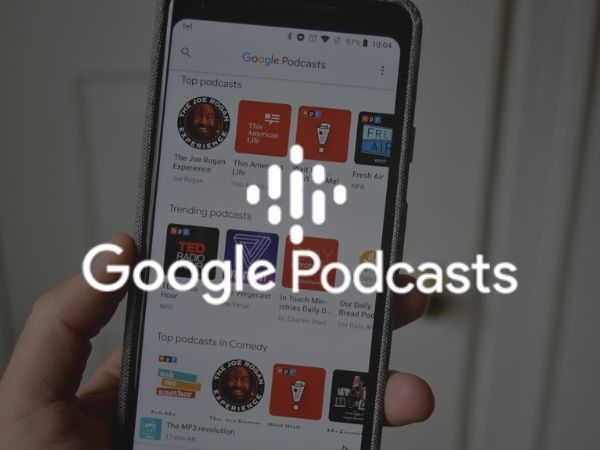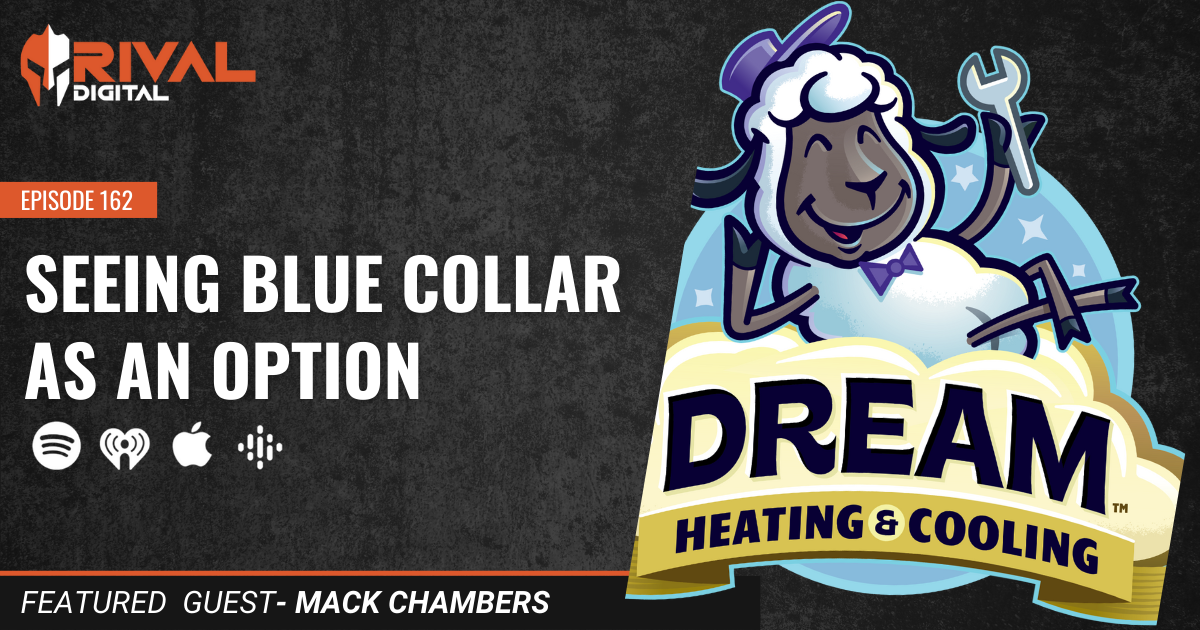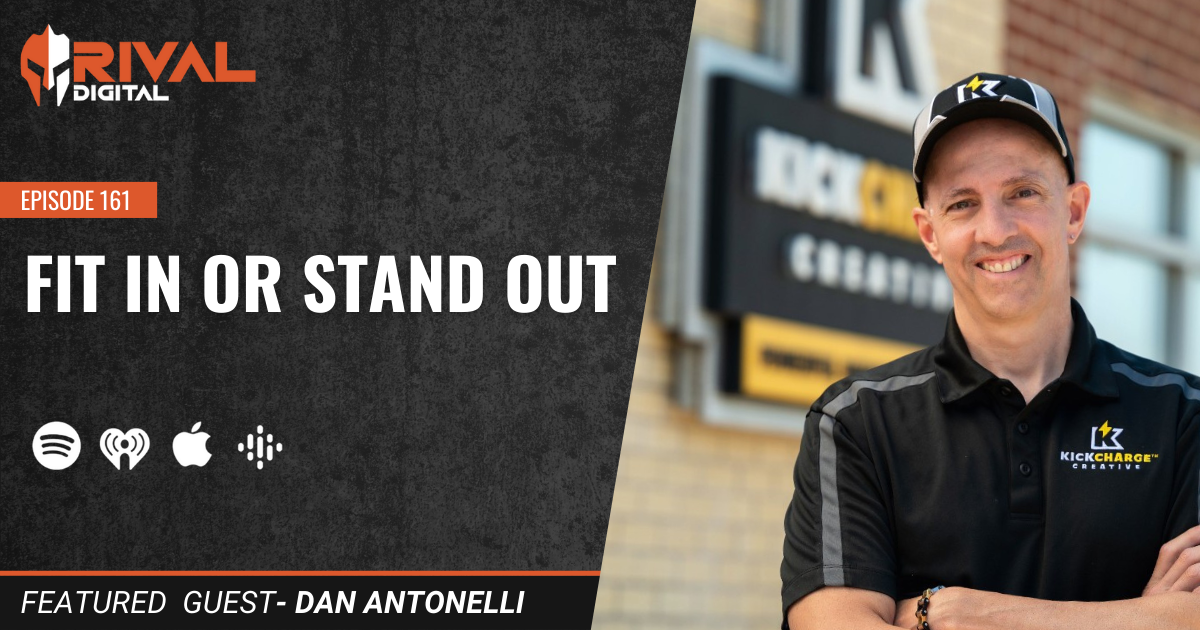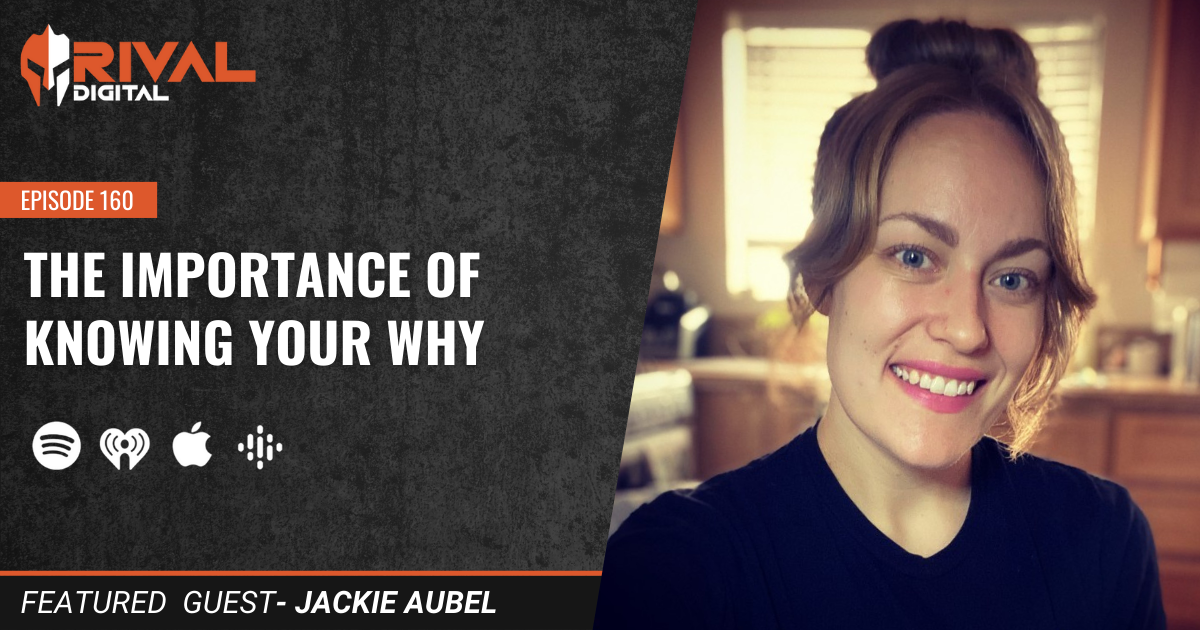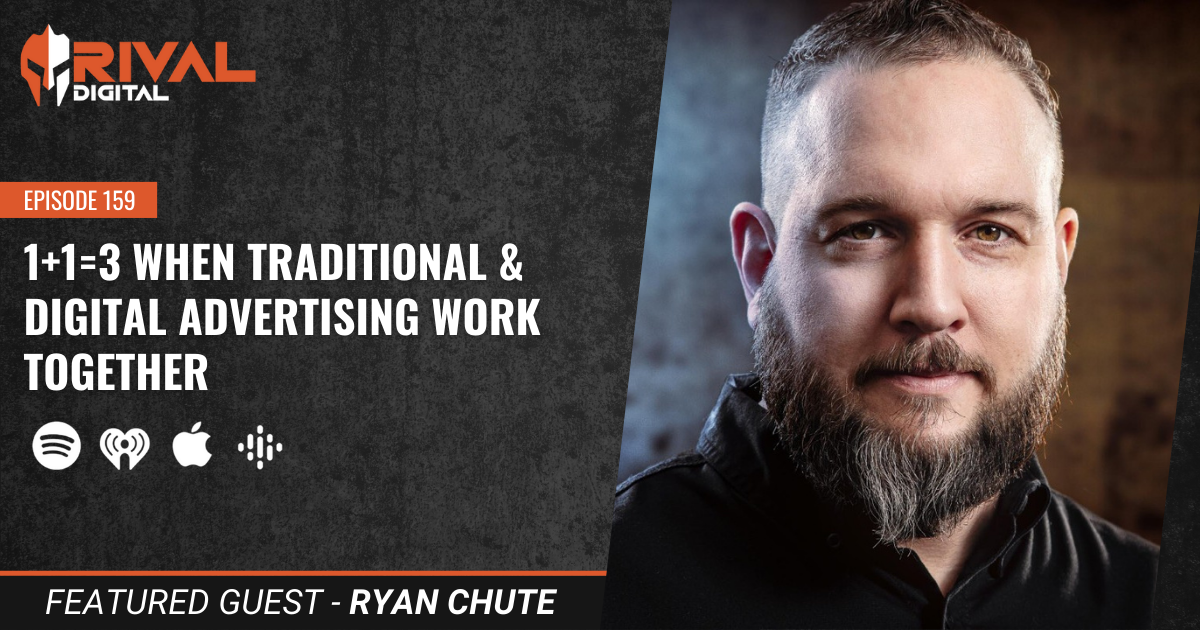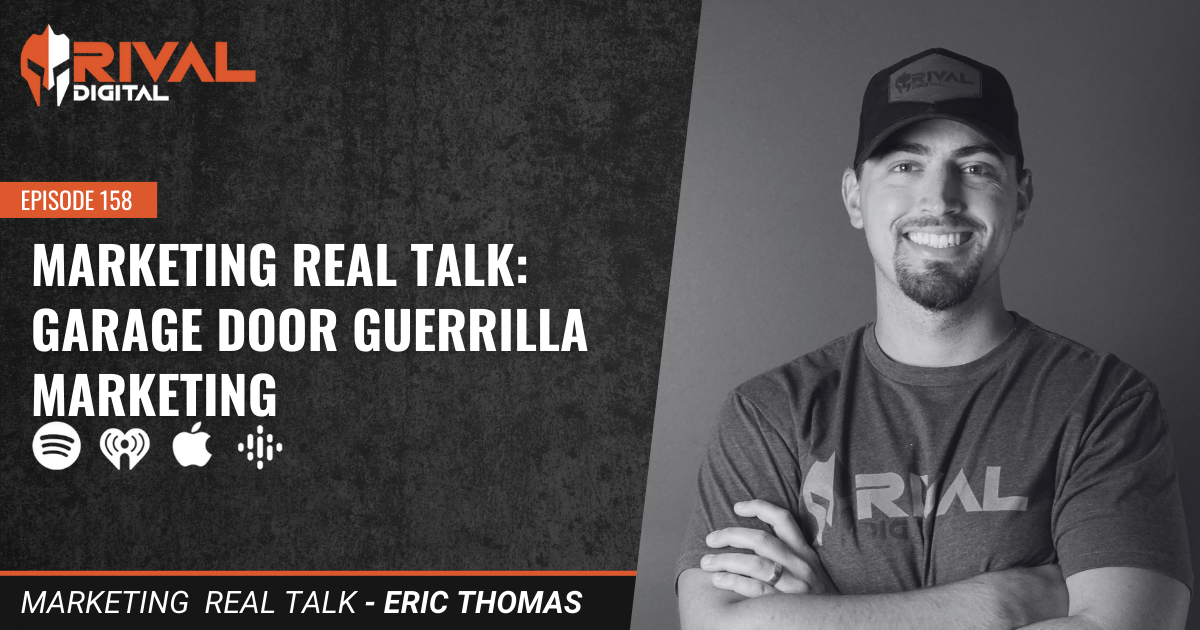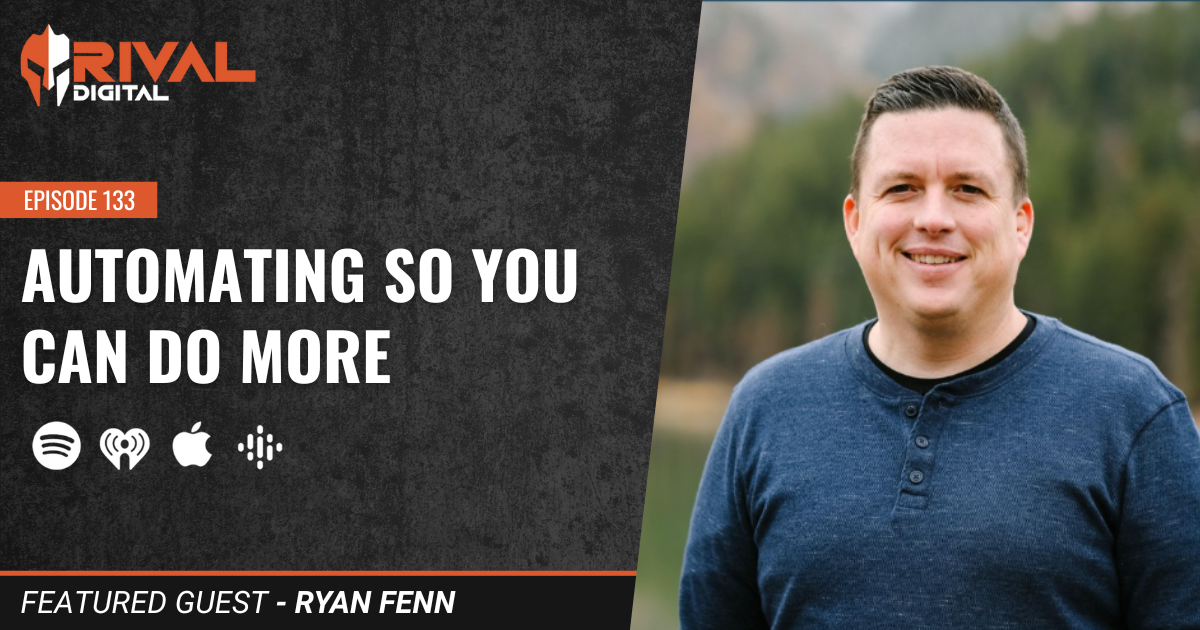
On this episode we have Ryan Fenn, CEO of CHIIRP on the show, recorded from the Women in HVACR event! Eric and Ryan talk about communication automation, automating review requests, while not taking away the human element in your business.
Ryan and his brother started a business 12 years ago, and Ryan even made a course on how to grow and build your business. Now, he’s focused on growing your business through automation. Automating allows you as the business owner to be able to do more, while automation takes care of the rest.
Check our our affiliate link for CHIIRP here!
We want to give the human being super powers to accomplish more. Click To TweetThe Smart HVAC Marketing podcast was created by Rival Digital to help residential HVAC contractors and is now streaming on all major platforms. Follow along for ways to improve your marketing and grow your business as we continue interviewing more industry experts.
We do not own the rights to the songs in this episode. Should we need to remove it from the audio, contact us directly at podcast@rivaldigital.com.
Transcription
In case you prefer reading, these are mostly correct. Scroll in the box to see more.
Eric Thomas: [00:00:00] hello again and welcome back to the SMART H V A C marketing podcast where we believe the best idea wins. And we’re here to help you generate lots of good ideas. And to do we gotta bring on smart people like Ryan Finn from chirp. How you doing? Doing great. Generate lots of good ideas here so that you all can build a world class business.
I just made up that tagline. So that’s pretty good. No standard intro or outro around here. Kinda just make it up each time.
Ryan Fenn: Ryan, how’s it going? It’s going good. It’s going really good. Oh, that’s awesome.
Eric Thomas: Glad to hear that. For everyone tuning in this is our final recording that we are doing at the Women in H V A C R event.
This has been a really good time. I appreciate them inviting us out to record podcast episodes here. And so I think this is gonna be a good grand finale to talk to Ryan today about automat. For the shoulder season, membership, sales, integrations with Service Titan, all that good stuff. So Ryan, why don’t you take it away, introduce yourself, tell the listeners out there how you got your start in the industry and kinda go
Ryan Fenn: from there.
Sure. Thank you so much. Yeah, [00:01:00] my, like I said, my name is Ryan Finn. I’m the CEO here at chirp, that’s C H I R P. Don’t forget the second I, if you’re chugging it out my story goes back. 40 years ago. No, I’m just kidding. . No, about I actually didn’t start in this industry. I started my first business about 12 years ago.
My brother and I started a windshield repair business. We were out there fixing windshields and we got pretty good at what we were doing. We got to where we had scaled it up to where we had nine different location. And around then I had this kind of crossroads where I could keep scaling this business or try to take it more globally with a, an offer to help people build their own windshield repair businesses.
So I, I started putting together a training program. put together this training program over a year did videos. This was back before making courses was cool and. In 2015, I launched that course and it started to sell like crazy. I was selling it using automation. I was figuring out how to piece together automation, and I made $2 million [00:02:00] selling this course.
And and I saw that the process I was using to automate my sales process was, and I was duct taping together a lot of stuff, to make it work. And I thought, man, if this works so well for this, I should probably try. Take, this pattern of helping other entrepreneurs and go let’s put a software together that makes this sales process possible for all businesses.
And that’s when we got the idea to start chirp. We started about four years ago and we were like, Hey, let’s sell this to anybody and everybody. And, people came along and then as home services started to use it, we started to really. Some awesome benefits from it and a lot of people having a lot of success with it.
And we started to integrate with Service Titan House Call Pro. We just finished the integration with Jobber Service Monster. Sarah is almost done as well. But as we started to build those integrations, we started to really take off in the home service industry, and that’s how we got here. Yeah.
So
Eric Thomas: just from a high level view, what does CHIRP
Ryan Fenn: do? Yeah. [00:03:00] Automation, can mean a million different things, right? We focus on communication automation. We wanna make sure that the the customer is having an awesome experience from a moment they become a. All the way through the entire customer journey.
We wanna automate the outreach so that, you’re converting more leads on the front end, you’re communicating more effectively. The moment that a lead becomes a lead, we’re following up consistently with every single lead, every single estimate, using text, messaging, email, and ringless voicemail.
And then we wanna make sure that after a job is complete, that all of the communication is done for you, for, from all the way from the review request to, filter change reminders throughout the year all the stuff that can nurture a customer and maintain them so that when it’s time to rebook, it’s a no brainer.
They get a text message, Hey, it’s been 12 months since your last service. Let’s get you back on the schedule. Yeah,
Eric Thomas: yeah. You hear automation thrown around so much these days. I personally, I love Zapier. Yep. I just, [00:04:00] I use the heck out of that for everything, but it can really mean a lot.
What are. What are like the top two or three ways that contractors can utilize automation or, a tool like chirp
Ryan Fenn: to Yeah. Stay busy. Let’s talk about, being more intentional with your automation, more laser focused with your automation. That’s one of the big problems that people have cuz these systems don’t communicate.
You have Zapier to bridge the gap. Softwares, but a lot of times there’s a lot of stuff that’s lost in between those two things. So you’re only able to do general automations. So we took it really deep into service Titan. We took it really deep into house called Pro, really deep into job or and doing the same thing with Sarah as they continue to improve their product.
But the key is we want to be able to trigger automation at the exact right moment with the exact right customer. We don’t wanna. Communicate with everybody exactly the same way. Every job is different. We want to treat them differently based on different things that are happening within the crm.
Okay? [00:05:00] So for example let’s say you trigger an estimate to go out in. In Service Titan we wanna follow up with that estimate if it doesn’t close. And a lot of businesses are not doing that. They’re picking up the phone maybe once, maybe picking up the phone twice to follow up with an estimate.
Yeah. And then it’s gone. They lose, they, they lose that opportunity that may have converted had they been a little more assertive with their follow up. But it’s really hard to do. It’s a lot of work if you’re gonna do it without automation following up consistently with every. Lead can be
Oh yeah. It’s like a full-time job, and but you don’t wanna follow up, for example, with your high ticket items, the same way you would follow up with a low ticket item. It’s a different cadence, different sequences. And so what we do is we go on a service titan and we say, okay, if an estimate is sent and it has this job type or this business, you this.
This line item, this tag, this technician, this invoice value, whatever, all these different filters I [00:06:00] can choose and say, then do this campaign. Does that make sense? Yeah. And then I say, but if it has this line item or if it has this job type or this, invoice amount or whatever it is, do this campaign.
And now I can custom tailor, these campaigns for very specific job types that we’re doing. Yeah. So with awesome
Eric Thomas: things like automation, there’s still, there’s still gotta be a human element to that, right? So like the CSRs and the dispatchers and, whoever’s in the service type still has to tag the job or the estimate.
What happens or I guess, lemme back this up. What, how should contractors go about. Communicating the value of like properly marking things in service Titan for different automation
Ryan Fenn: campaigns. Yeah, that’s clearly a challenge, that you gotta take. We’re definitely not eliminating the human element entirely.
There’s definitely. A need to maintain your database, and it’s definitely something you should heavily train on so that you are specifically doing that. But if you do, it can, that little thing can mean very big things. Yeah. [00:07:00] Very big returns. And by, we talk about that. We never wanna completely automate out the human being from this process.
Yeah. We want to give the human being superpowers to do more and accomplish. So we’re never, we’re not trying to get rid of people’s jobs. We’re trying to make them more effective in their jobs. And when I say that we can do things like, these text message follow up that are going out or these email follow ups, it’s, mostly text message.
We have a 98% read rate on text messaging, so it’s the most effective way to communicate, but the. The key here is that we’re trying to trigger conversations. We’re not trying to close deals, we’re trying to trigger the conversation. So for example, a text message might go out. I can’t tell you how many times I’ll have somebody comment in our group that’ll say oh man, a three week follow up just went out, and the guy responded and said he’s ready to go.
No companies aren’t following up three weeks, four weeks later without automation. And then when that person pops back, And they say, yeah, sorry, I’ve been sick. I just had a guy say that he got a, he got a hundred thousand dollars job closed. From a three week [00:08:00] follow up. The guy had gotten sick, stopped, started ignoring his initial text messages from the estimate.
A three week follow up, went out and said, Hey, it’s been a few weeks, haven’t heard back from you. Just wanted to make sure before I close this estimate out if you had any questions. And the guy said, oh, I’m so sorry I was sick. Totally forgot. Let’s revisit. And then they got back on the phone. Yeah, of course he didn’t close the.
From that text, but it retried the conversation. Yeah. Was able to get ’em back on the phone and close the deal. Yeah. So like when, yeah, when we’re talking
Eric Thomas: about that, like
Ryan Fenn: rehashing
Eric Thomas: leads, cause I’m sure there’s so many contractors out there that have millions of dollars of unsold estimates, just chilling, just sitting there in their crm.
So what have been some of like success stories that you’ve seen from contractors implementing automation and campaigns like that?
Ryan Fenn: Yeah, so let’s talk about I just actually did a podcast with Dustin Miller. He owns comfort now in in California. Super cool guy. One of the ways he talks about how.
He keeps his shoulder season fully [00:09:00] booked throughout the year using chirp or not throughout the year through the shoulder season. . Yeah. But he, he may, he, so one of the automation campaigns that he does is it’s a blend of ringless voicemail and text messaging. And the way that he does this is gonna sound super simple, but this has booked him millions of dollars in jobs over the last three years.
He reaches out to customers that he has not serviced in a year or more. He sends, and this is all something done automatically. A voicemail goes out. If you’re not familiar with ringless voicemail, it’s where it’s just sending a voicemail right to the phone. So they see their phone, they see that there’s a voicemail, and they listen to it.
And basically what he says hey, it’s Dustin with comfort. Now, I first wanted to say thank you so much for being a customer of comfort. Now, I just wanted to let you know it’s that time of year. Right now we have 50 available slots for a deep discount on our tuneup. It’s only 49 bucks. If you’d like to take one of those slots, just text me back on this number or call me back.
He, and that goes straight to their phone. It’s all automatic. They listen to that and he [00:10:00] can’t he, it blows me away. Every single time I do that, I get, I just get called back. Hey, Dustin just tried to call me. I wanna get one of those slots. I wanna get one of those. And then for those that don’t book 10 to 15 minutes later he has a text message go out that says, Hey my boss Dustin.
So it’s it’s coming from the CSR at this point and says, Hey, my boss Dustin just left you a voicemail about these $49 tuneups. We still have some slots left. Would you want to wanna sag one of those spots? Then they’ll get texts back. Yeah. Let’s do it. And then he does one more follow up a day.
That says, Hey, just wanna let you know we’re about out of those spots. Just wanted to follow up one more time, see if we could get you on the books. That simple three step campaign, voicemail, text message. Text message has booked millions of dollars in sales during the shoulder season. He, he talks, and we talk about this a lot during shoulder season.
Marketing is not it’s hard to spend money in the shoulder season of marketing. You’re not people. Anxious to get their stuff worked on. Yeah. It’s not hot, it’s not cold. And and so you need to take advantage [00:11:00] of your existing database, what you already have, get those people that you, the low hanging fruit that you already have in your database.
Yeah. With that. So that’s one one of a thousand different automations we can talk about. That’s extremely effective. Yeah.
Eric Thomas: Yeah. Shoulder season, cuz we’re, I mean we’re, it’s November 4th and. 57 degrees in Phoenix, Arizona. Yeah. So I’m sure they’re not common with air conditioner. I’m sure the air conditioners are just breaking down left and right now, yep. .
Ryan Fenn: Yeah,
Eric Thomas: I think like shoulder season in particular, so many contractors, I feel like they just, they don’t throw in the towel for the year, but they just it’s a mindset of. It’s just shoulder season.
Ryan Fenn: It’s gonna be slow. It’s gonna be slow. Slow. And they kinda just are Yeah.
Just ready for it. And it doesn’t have to be, it doesn’t have to be
Eric Thomas: like, yeah. A $49 tuneup isn’t a, that’s a loss leader
Ryan Fenn: in most cases. Oh yeah. Yeah. It’s a sell. It’s gonna be a
Eric Thomas: huge loss leader if you just treat it like a $49 tuneup. Yep. [00:12:00] Rather than just an opportunity to keep your people.
Ryan Fenn: And busy. And he, from that he’s booking, replacements and Yeah. And everything. At that point it’s all really just a loss leader to generate a lead for a potentially bigger opportunity. For sure. Yeah. So what are some
Eric Thomas: other, what are some common challenges that you see contractors facing when it comes to automating
Ryan Fenn: follow up and stuff like that?
One of the big things that people have a problem with is, taping together multiple systems. And that’s where, you talked about Zapier and it’s, you gotta have a tech degree to figure some of this stuff out, and and that’s where we stepped in and said, Hey, you know what, if we create this directly, this can be a lot easier to do.
And then if we provide the service of building these automations for clients, that’s, something that we offer so that they’re not having to. Figure this stuff out on their own, cuz it’s, this is like full on nerd stuff, yeah. And these HVAC guys are like, I’m not a nerd.
Yeah. So that’s where my team of nerds steps in and helps with the process. But the [00:13:00] key for us has been the direct, the very direct integration so that you’re not having to duct tape together a million different systems and you’re not having to change what you’re doing. So when we trigger an automation, it’s not something you’re going in and saying, okay, I just sent an estimate out.
Now I need to trigger the follow up. The, just by virtue of sending out the estimate, you’ve triggered that follow up to start. And so it’s, you’re not changing your process, you’re stealing what, still doing what you would normally do in service. Titan and Chirps, just responding from that. So I’ll give you an example.
This is again back to Dustin Miller. One of his estimate problems estimate rehash campaign problems was he had a follow up system that was separate and he, and this follow up system would go out over, two weeks and it would send text messages over two weeks to try to get an estimate to convert and.
He had to, the problem was, is because the two systems didn’t communicate, he had to [00:14:00] remember if somebody booked the job from the follow up, he had to remember to go in and shut down that campaign. And if he forgot, the customer that had booked would then get another follow up. Hey, do you wanna, follow up on that estimate?
You wanna get that estimate. And that was a problem cuz they’d be like, I already booked. And especially if you started to offer a discount later towards the end, then it’s Hey, do you wanna, I’m offering a 10% discount right now. And they go I booked yesterday, but I’ll take that 10% discount.
It’s oh shoot. So the key is that you, the systems need to communicate both ways, both to start and then to stop at the appropriate times as well. Yeah. And again, this is all total nerd speak right? That’s what we help with. So we don’t just say, Hey, here’s our software.
Good luck. Yeah we’re here to implement and help you with automation through the whole process. There’s a lot of softwares out there
Eric Thomas: that do that.
Ryan Fenn: Yeah, exactly. We’re like, thank you for your purchase. Yep. And then you can’t ever, you never hear from ’em again. You go in our chirp user support group and we have, everybody talking about it.
We have our expert automation [00:15:00] pros that are there to build stuff for you. Whenever you go, oh, I have this cool idea. I wanna set it up. I actually I have, I just had a really cool one that I wanna share about memberships. Do we wanna go down that path now? Oh yeah. Let’s hit it. Okay. So membership sales are obviously, something that is a hot topic.
Some people like ’em, some people don’t. Yeah. But the selling memberships is always a problem cuz you’re trying to train technic. To sell something. And generally technicians, unless you have, some of the few that are really good, most of ’em are just technicians. They’re not sales guys.
Yeah. And so we talk about framing, sales framing and getting the conversation right so that the technician can actually sell. And this process is, I think, gonna be really killer. It’s fairly new that we kinda came up with this, but you can So one of the, one of the triggers within service Titan and house call pros.
Is technician dispatched or on my way? Yeah, those are the triggers, right? So you click technician dispatched. Okay. One of the cool filters in Service Titan is we can [00:16:00] see whether or not it’s a member or a non-member already, so we’ll treat them differently. If it’s a member, we’re not gonna do this.
If it’s a non-member, what we’re gonna do is we’re gonna hit technician dispatch. That’s gonna trigger a campaign in Chirp that’s gonna send out a text message. It’s gonna say, Hey, first name, obviously gonna replace that with their first name and say, Hey, first name. Your technician, John is on his.
You should expect ’em in the next, 45 minutes, whatever you wanna say. This is fully customizable. And then you say, and then this is the magic, the simple line right here. By the way, if you’d like to save money on this call, ask our technician about our membership program. That’s it.
That’s the magic right there. That one sentence Yeah. Is a sales framing strategy. What that does is it puts it in their head 45 minutes before the technician’s even gonna get there or whatever. And it says, ask him about the member. So they’re thinking about it, and then when the technician gets there, they ask, Hey, how can I save money on this call?
And now the technician doesn’t have to remember to bring up memberships. Yeah. It’s not an awkward conversation. He can just go, oh, perfect. [00:17:00] Yep. What we can do is, this is our membership program. This is how you save money on this call if you wanna go, if you wanna, yeah. And that. I mean that right there, if you’re just like, Hey, did you ask that?
Did you bring up memberships? Did you bring up memberships? And they’re like, oh, I forgot. I forgot. Instead you put it on the customer to do it. Yeah. That’s really smart.
Eric Thomas: I think I had Marcus Sheridan on the podcast. Marcus Sheridan. Yeah. From he wrote, they ask you answer and he was talking about assignment selling where, you know, before a service visit or before an estimate you’re hitting the customer with Read this before we
Ryan Fenn: show up.
Yeah. It’s framing. Yeah. Yeah. And
Eric Thomas: so he’s like leading up to that appointment’s, like your technician’s on the way. The last thing is here’s a bio about him or whatever. But that’s really smart because at that, if you walk into the home and the homeowner is already prepared to sign,
Ryan Fenn: It’s a slam dunk.
90% of the sales job is done by that text message. And then if they ask, if they ask, cuz you already, it already says in there, ask about our [00:18:00] membership program. If they ask, they’re interested. Done. Yeah. They’re not gonna ask if they’re not, if they’re not interested in the membership program they’re not gonna ask.
So it’s, like I said, it’s basically just the technician at that point, taking an order, like saying, okay, cool, let’s get you going. Yeah. No, that’s huge.
Eric Thomas: Memberships estimate, rehash follow up. What are some other capabilities of chirp that a lot of contractors utilize?
Ryan Fenn: Yeah, let’s talk about the front end a little more on lead conversion and then post job as well.
Lead conversion obviously is a big thing. Speed to lead or, contacting the lead within a certain amount of time. I have a chart on one of my demonstrations on the website that shows how quickly. A lead, and this is not just hvac, HVAC specific. This is leads in general. We have extremely short attention spans as human beings, and they’re getting shorter and shorter.
TikTok, you can think TikTok for that. We’re getting Yeah. Way more. And so if somebody expresses interest in something, [00:19:00] the chances of converting that lead is the highest in the first minute. So if they submit their information on your website, or let’s say it’s an Angie lead. A lot of people hate Angie leads, but a lot of people do have good success with Angie Lead if you do it or it’s a Facebook lead or whatever it is.
If we do not contact that lead within one minute. The conversion rate drops and it drops dramatically. It’ll actually cut in half within that first minute and then down to four on one fourth within three minutes. Yeah. And so by automating your outreach to that lead, you can contact the lead through text message within 30 seconds.
So Yeah. You have Angie lead, you’ve got five, five other contractors you’re competing with to get that deal. Yeah. If you capture the lead and send a text message, In 30 seconds, you’re likely gonna be the first person to contact Oh yeah. Lead. So that’s a big one. And then that automatically triggers the follow up.
If they don’t convert automatically puts all their data into their into your crm so you’re not having to double enter, you the information. Yeah. Lot of cool stuff there. And then post job people are using different systems for like review, outreach and things [00:20:00] like that to get reviews.
We find that it is extremely effective if you’re using the same conversation thread from the moment the lead became the lead all the way through the entire conversation, and then asking for the review from that same same phone number in the same thread. You’re basically automating. I call it, relationship automation.
You’re building a relationship with the customer throughout the whole job. And then when we reach out, say, thank you so much for doing work with us today. We really appreciate it. Would you leave us a review? Yeah. It’s all in that same thread. It’s all from the same conversation from the moment, let’s say it’s that Angie lead, right from the moment they became an Angie lead, they get a text message and you’ve communicated with them perfectly through the entire job.
And then you’re asking for the review all in that same threat. So that’s, yeah. Super powerful. And then from there, we get the. We can even trigger things like if they leave a five star review, send ’em a $10 Starbucks gift card or whatever we wanna do. All automatic.
We have guys that, we have guys that send out, like gift baskets. They’ll say, Hey, if the invoice is more than $10,000 automated gift basket with my logo on it. [00:21:00] Yeah. That kind of stuff. And then drop them into, Annual nurture campaign that’s gonna send out your filter change reminders, your emails, leading up to the next appointment in a year.
Yeah. So that,
Eric Thomas: that’s really powerful stuff. So does chirp with your automations, do you have the capabilities, I know that CHIRP has a web chat
Ryan Fenn: right? You have a chat? Yeah, we do have a web chat. We got like contact forms. Does it work for Yeah, we have contact forms. We can, we have a form builder or you can connect to existing forms you already have on your website.
Gravity forms. You can connect to those. Yep. Nice. So anywhere that somebody can submit information, we can capture Facebook lead forms. Even if you have direct mail with QR codes on it, you can start a text message conversation right from those QR codes. Just think of, any way that a customer can submit information, we can capture that data and start the text message conversation.
See, that’s,
Eric Thomas: that’s really strong. I think the Facebook lead forms stand out to me contact forms on sites. Obviously naturally them and web chats are great, [00:22:00] but we see a lot of times with lead forms on Facebook because of how easy it is to submit it. Oh, yeah. That by the time the contractor calls the customer’s yeah, I don’t remember doing that.
Yep.
Ryan Fenn: I talked about that windshield repair course. Yeah. That’s how this whole thing started, was. I sold that course through win through lead forms on Facebook. I generated 250,000 lead forms on Facebook over a four year span, and by texting them immediately, we had a high conversion rate.
That’s the different people go, oh, those forms suck. Did you call ’em? Yeah, I called ’em, but it was like an hour later, yeah. That’s the problem. It’s not that the lead form sucks, it’s that it’s a top of funnel. That needs to be. It’s like it’s a seed in the ground with just barely starting to sprout.
It’s not ready. Yeah. And so it’s you shouldn’t say the lead sucks. It’s a person raising their hand and saying, Hey, I’m interested. You just need to know how to properly convert those leads. Yeah. And if you use automation to contact them quickly, you can maintain their [00:23:00] attention and then you can work on selling that lead.
But it does take that extra. And
Eric Thomas: I think that there’s like generally just like a difference between a lead from Facebook and a lead from Google. Cuz like Google is a reactive, like intent based program or platform. And so people are going there with a problem or a question, whereas with Facebook, like that’s more intrusive.
Like you’re stopping them. And if you somehow have done, your attention, interest, desire, action correctly and everything. Yep. And then they finally say, okay, and then they click on. After they click on that, they’re gonna keep scrolling to the next video, to the next
Ryan Fenn: thing. And yeah, think of it like this, right?
You have, there are pros and cons, right? You have Google, like you said, it’s intent versus disruptive. That’s the key. Those are the key phrases, right? Intent search versus disruptive marketing. Right? Intent. I search for it. I want this thing. If you look at the funnel, like I’m, if you’re just listening this side, my hands up shaped like a.
That those guys are right at the bottom of the funnel, right? They’re like ready to go. Cause they’re searching, they’re actually thinking about this thing. [00:24:00] If you’re on Facebook, you’re not thinking about hvac. You’re just on Facebook looking at whatever. And it’s and then they see your ad.
It’s the same as if somebody had knocked on the door and disrupted their day, and said, Hey, I’m here to sell you h. Totally different approach. Doesn’t mean that it’s bad, it’s just in a different part of the funnel. They’re higher up. The benefit though, of Facebook marketing or any kind of disruptive marketing is that you have a much broader audience to go after and you can capture a much bigger market share because you’re being proactive rather than reactive.
You’re not waiting for people to search. You’re gonna go out and search and find customers. It just takes more work to convert ’em and using automat. You can do that. It just, there’s just a different process. I really it hurts my ears when somebody’s oh, those leads suck. I can’t, it’s no.
Yeah, the lead doesn’t suck. It’s your conversion process. You gotta figure out how to convert ’em better. Cuz the benefit is that you’re not fighting on Google. Everybody wants those leads. So you have to compete and you pay a lot more for ’em cuz they’re the best. But you can step out of [00:25:00] that and go over to disruptive marketing and capture a much bigger part of the.
If you know how to do it.
Eric Thomas: Yeah. And even even when the lead sucks, they, people say the lead sucks because they called and then the person either didn’t answer, didn’t book, didn’t do anything, but that is still a person who at one point in time raised their hand and Yep. And signified. This is something that I’m interested in.
Even if it was Google or Facebook or Angie, or they went somewhere on the internet and
Ryan Fenn: said, I need this. They have, yeah.
Eric Thomas: They’ve acknowledged that their current situation isn’t desirable. Yep. And they’ve given you their contact information and then what are you gonna do with it? Just let it sit there and do nothing.
Yeah. The worst thing you could do is, like worst case scenario, you put ’em into a nurture campaign and you’re just peppering them with blog articles and
Ryan Fenn: Yeah. You think about it like that, you go, okay. If you treat a Facebook lead the exact same as you will Google lead, yes, you’re gonna say, yeah, these leads suck.
But then you go if I put into automation into play, [00:26:00] okay, text message goes out. They don’t respond to it. Cool. Tomorrow, another text message go out A few days later, we’ll follow up again. A few days later, we’ll follow up again. and then all of a sudden after a week or two a response will pop back up.
Hey, sorry. Yeah, let’s go ahead and get going on that with zero work done on your end. Yeah. So instead of sitting there going, oh, these leads aren’t converting, you’ve got, let’s say you spend, a certain amount of money over a month and you generate, a hundred leads or whatever it is.
You just let the automation take care of it and then all of a sudden they start popping back up in, in the system, oh, I’m ready to go. I’m ready to go. They aren’t so they aren’t leads now. They’re good leads. Yeah. You just, you let the stuff do the work for you and then they’ll pop up as good leads.
Yeah. Insult. I
Eric Thomas: always use fishing in. Oh yeah, for sure. Whenever I’m making a marketing analogy, I just love to talk about fishing. Yep. It’s just like fishing you, you go out there and you pick your spot on the pond. Yep. You got your hook and you got your bait, and you throw it out into the water, reel it back in, and you don’t catch anything.
You’re not gonna say, this hook sucks. Yeah. , [00:27:00] I’m gonna cut it off and put a different hook on. No, you just throw it again. Or you move spots and you throw it over there. Maybe you just bait and then you move and you throw it again. Eventually you’re gonna catch. But if you just stand in the same spot and throw the same thing out there, and then you just say, yeah, this hook sucks.
Ryan Fenn: I’m done fishing. Yeah. And then if you’re really good, you get a net and you cast that really wide and you get really good. And that’s where as you get better at digital marketing, you can cast these much wider nets. And if you have systems in place to nurture those fish they’ll grow into deals, yeah. That’s good stuff. Is there
Eric Thomas: anything that
Ryan Fenn: we haven’t covered yet that you wanted to chat about? Man, we’ve gone over a lot of the benefits to talk about site chat. Message broadcast is probably one that, is something that people really latch onto. That’s when you know, you have the ability, we have all these nurture on these automations, right?
But there’s times where you just wanna say, Hey, I wanna send out, a hundred messages to this group of people, or whatever it is. Oh, I wanna do a special or something like we can take your, when you sync it up with your system, we can pull all their data over. It [00:28:00] automatically pulls it over and you can pull up a list and you can send out a text message to a hundred people.
You can send it out to 300 people. I don’t recommend doing much more than that cuz you have huge response rates with text messaging. So if you do a hundred a day over a week you’ll see major responses. So that’s a really cool feature within the system. But really what it comes down to, it is you’re getting this, and I don’t, I guess it’s a sales pitch here, but when you do get on chirp you’re and everybody’s looking at, everybody’s looking at automation.
Everybody’s looking for ways to be efficient when you get it and have that automation expert in your back pocket. That’s the key cuz we’re here to work together and partner with you to make sure that it’s working for you.
Eric Thomas: That’s awesome. Ryan, this is, this has been a really cool episode. I’ve really enjoyed our conversation here.
What’s the best way for listeners out there to learn more and maybe schedule a demo?
Ryan Fenn: So if you go on the website there’s buttons all over the website that say schedule a demo. You choose, you can choose there’s a bunch of videos actually, if you scroll down a little bit more, keep going.
If you wanna watch, I do recommend watching. Right there. That’s the interview [00:29:00] I did with Dustin Miller. That’s a really good interview where he reveals some really cool strategies, if you wanna watch that. And then of course, book a demo with our team. You can go on there choose a time. Usually take about 20 to 30 minutes to go through all the different things.
And then if you decide it’s a good fit, we get you onboarded. Takes about a week to onboard and get you all set up with your CRM and get everything connected. And then we install, Core campaigns that we have the best part about this is you’re not starting from scratch. We have already prebi proven campaigns that automatically get built into your account.
You can tweak them, you can add to them, you can take away whatever you wanna do. And then from there you can build as many different automations as you want. We’ll help you do it if you have cool ideas like that membership thing and you go, oh, I wanna build something like this. We just help you put it together.
That’s really cool. And then once it’s up and running, these things are working in the background 24 7. It’s like having a follow up assistant that just, she never calls in sick. She’s never late. She does her work for you every day, so that’s awesome.
Eric Thomas: Yeah. [00:30:00] Awesome. Thank you so much for joining me on the podcast
Ryan Fenn: today.
Yeah, I appreciate it. Thank you so much for having me.
Eric Thomas: Absolutely. Thank you all again for tuning into another episode of the SMART H V A C marketing podcast. We will see you guys again next week. Bye.
Ryan Fenn: Thanks for listening to the SMART H V A C marketing podcast, powered by rival digital, helping business owners and industry professionals across the country stay ahead of the curve in an ever-changing business landscape.
We hope you learn something from this week’s episode. And don’t forget to rate and review this podcast. Thanks again for listening to the SMART H V A C marketing podcast.

